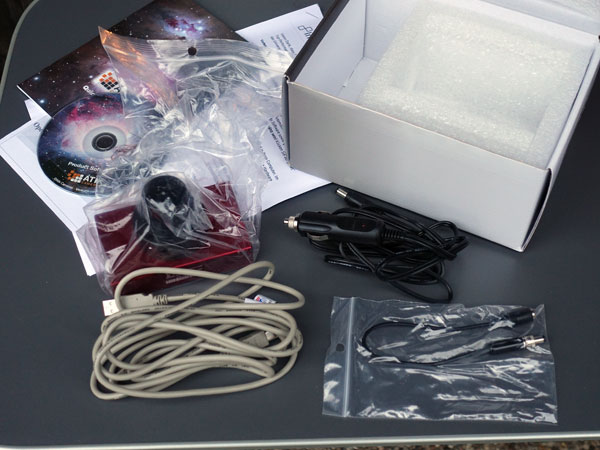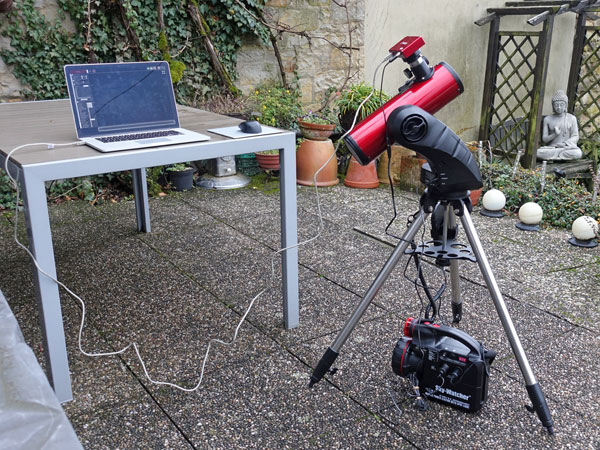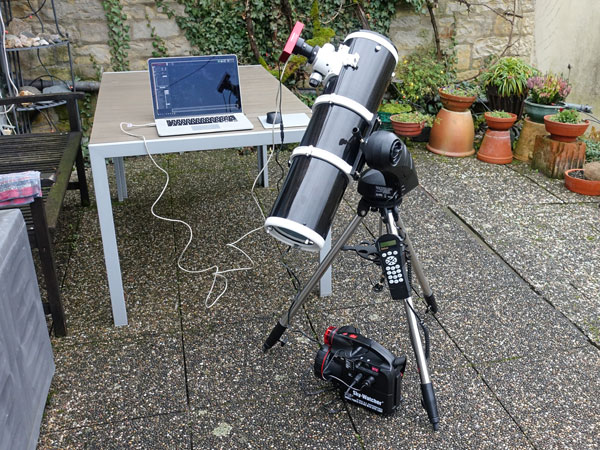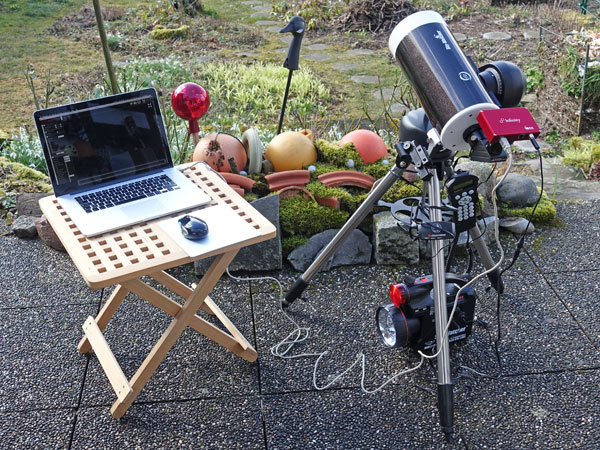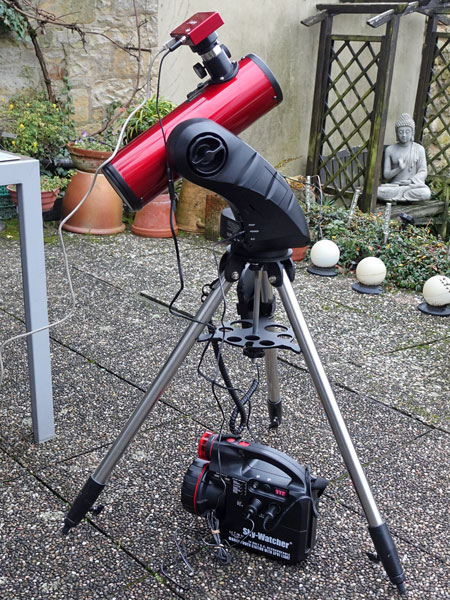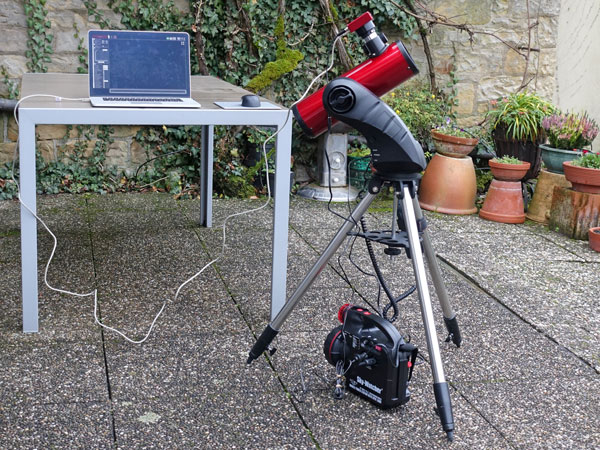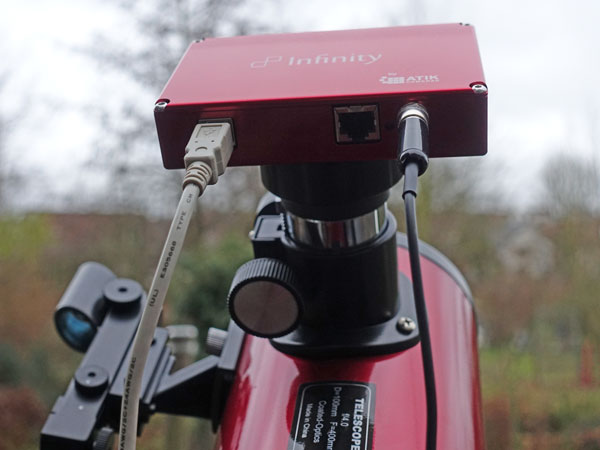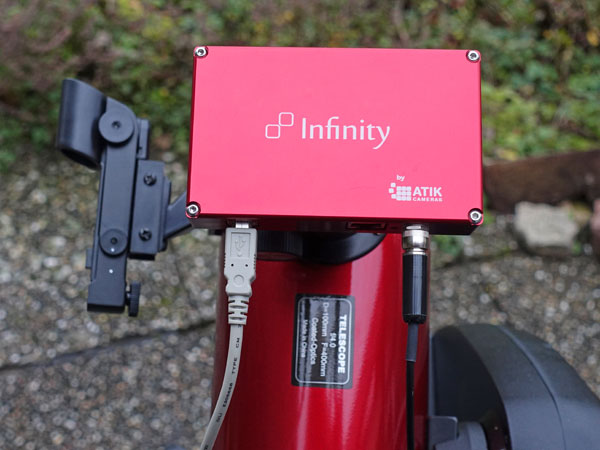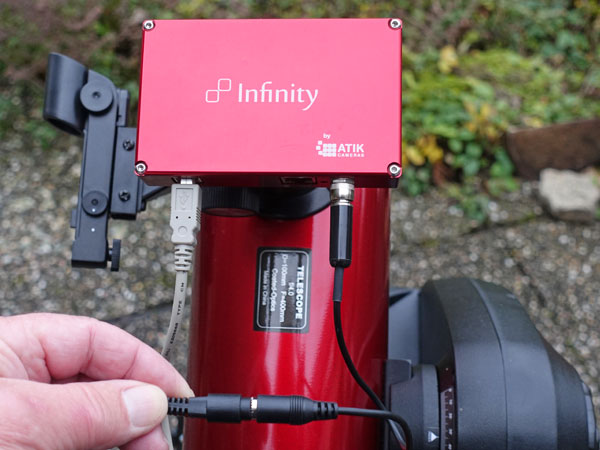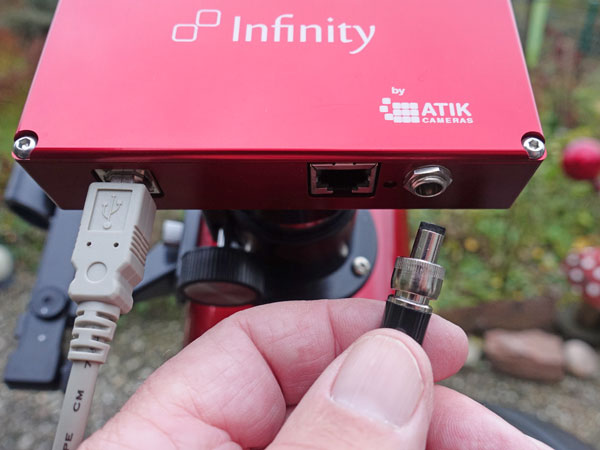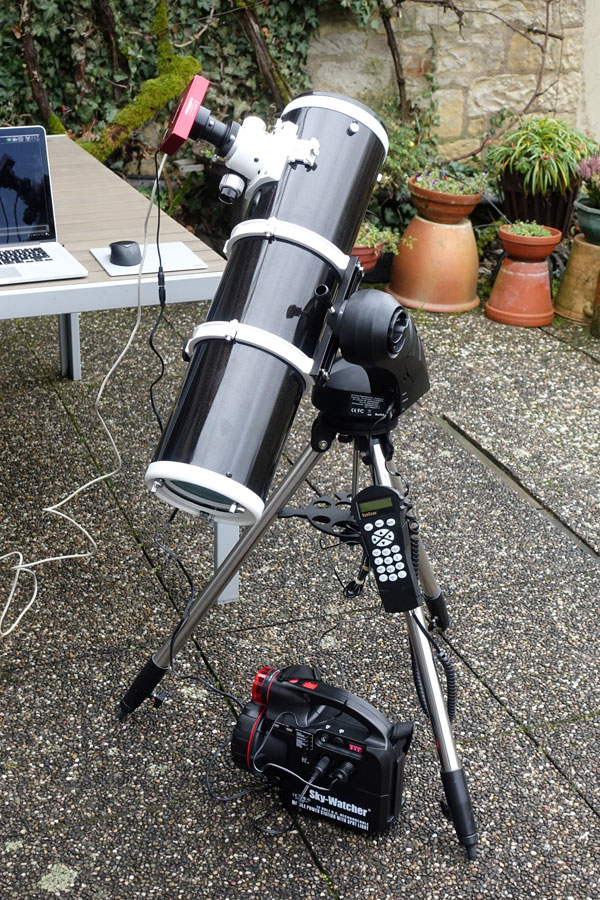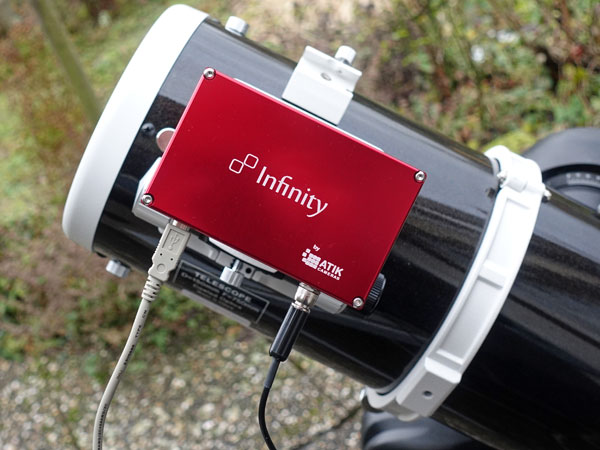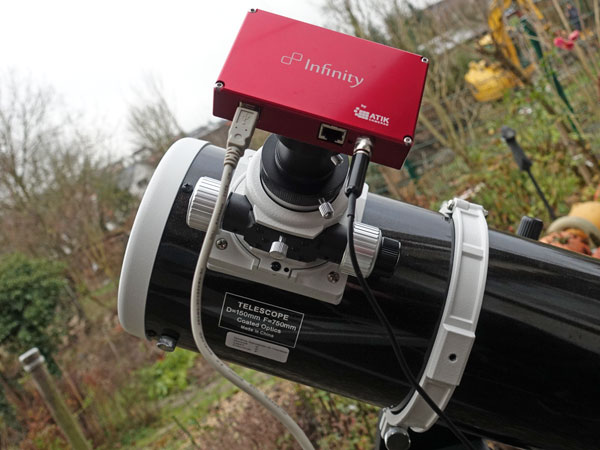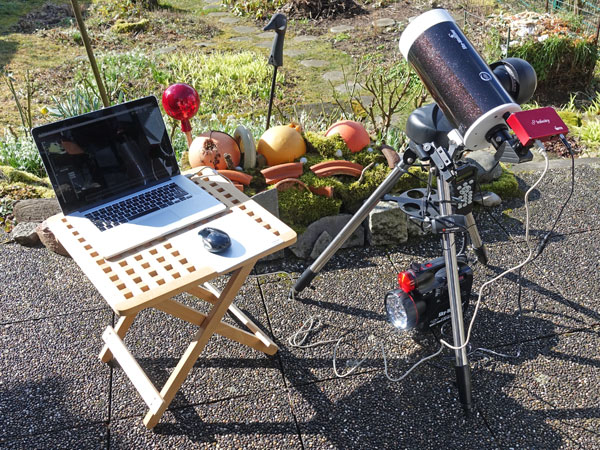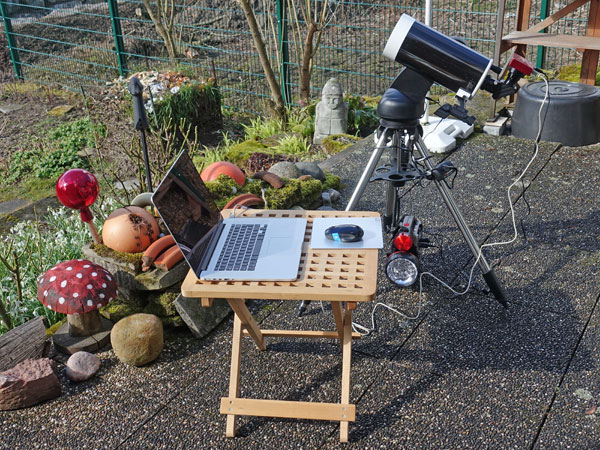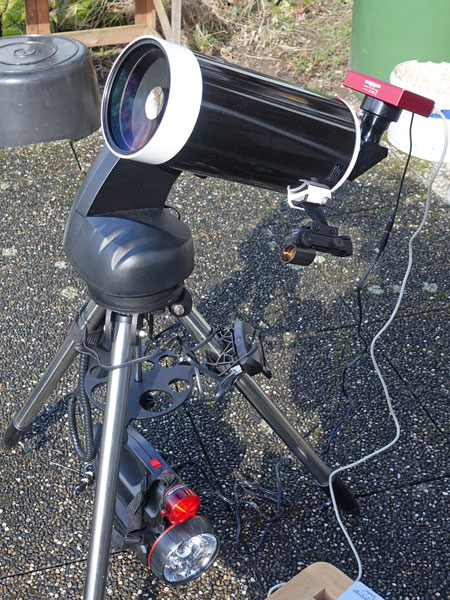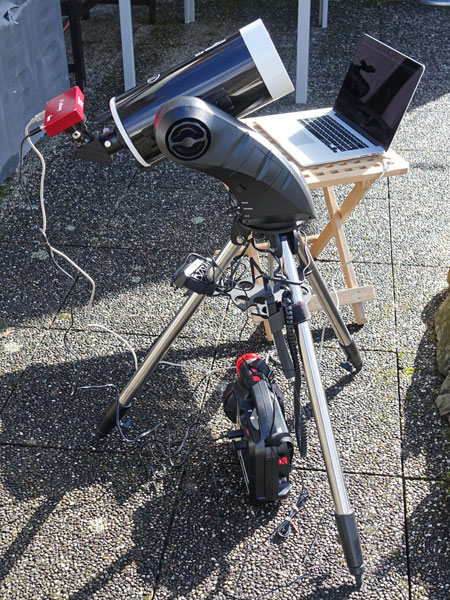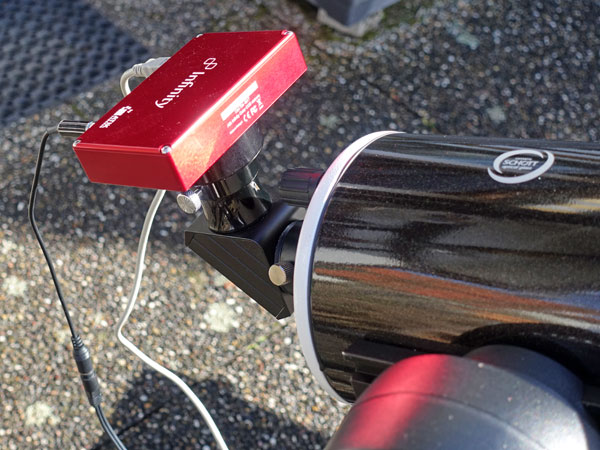Atik Infinity Colour Camera - First Experiences
Introduction | A few First Impressions... | Atik Infinity at Different Telescope Tubes | Preliminary Conclusions | Links
Archive
On this page, I present first experiences made with my Atik Infinity Colour* camera (received used on November 25, 2017). Possibly, these are useful for others who want to acquire this camera as well...
See also pages (Archive):
- Atik Infinity Colour Camera - Information
- Atik Infinity Colour Camera - First Experiences
- Atik Infinity Colour Camera - First Observation Sessions
- Atik Infinity Colour Camera - Further Experiences (Dry Runs) - Further Experiences (Nightly Tests)
- Atik Infinity Colour Camera - Software
- Atik Infinity Colour Camera - Field of View
- Atik Infinity Colour Camera - Photo Gallery
*) Usually, I would write "Color", because I try to use American English, but Atik is a company located in the UK, and therefore it's "Colour"...
Note: Over Christmas 2022, I sold my Atik Infinity camera (transferred on January 5, 2023). I therefore cannot report any further experiences with it here. |
Introduction
I bought the Atik Infinity Colour camera used at Teleskop-Leasing, instead of leasing it at first (received on November 25, 2017). They also supplied an adapter cable for the power supply that can be screwed into the camera und thus prevents the power cable from being removed inadvertently.
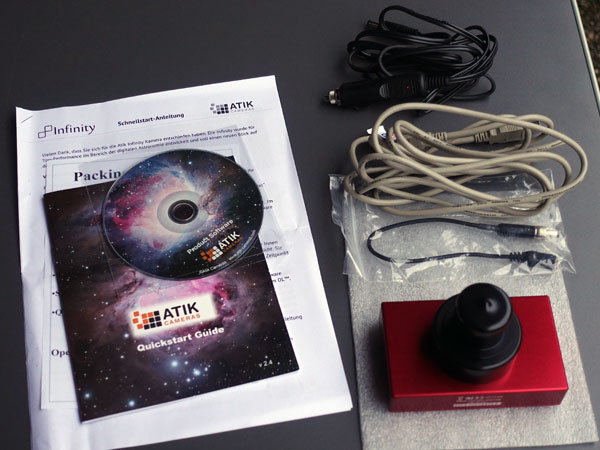 |
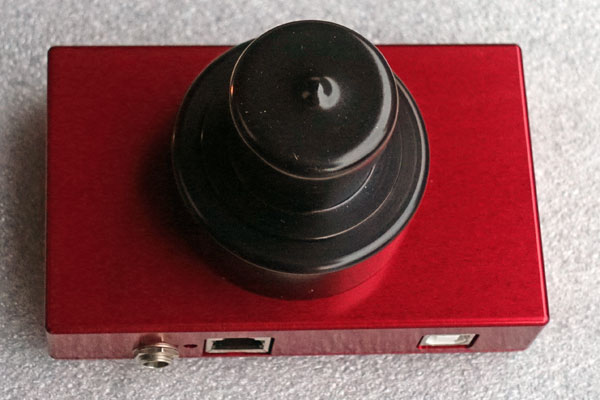 |
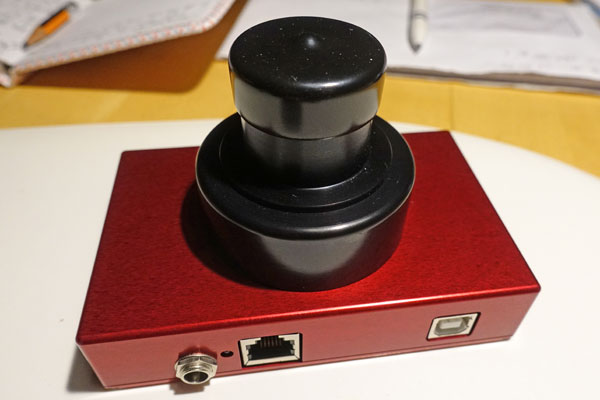 |
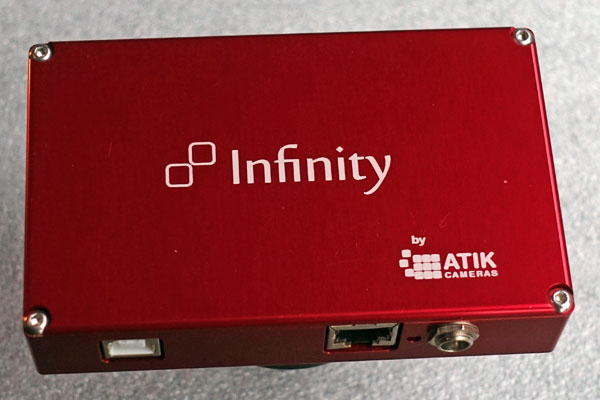 |
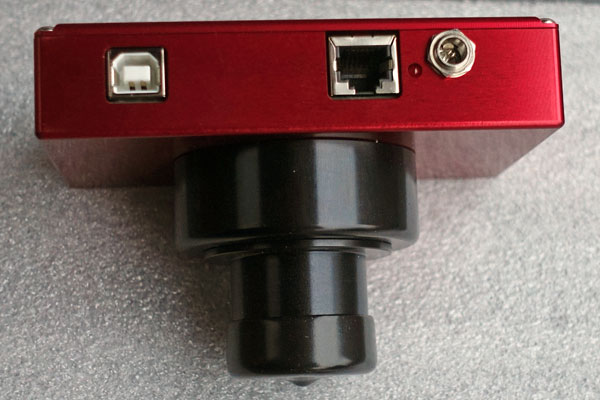 |
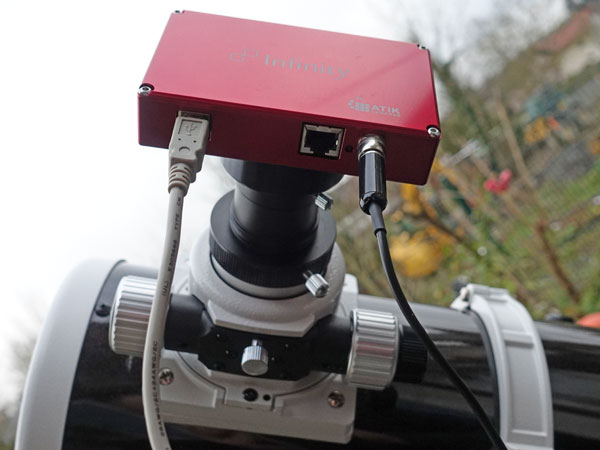 |
Just as a reminder how the Atik Infinity camera looks like...
A few First Impressions...
Scope of Delivery
The Atik Infinity Colour camera is originally sold with the following accessories:
- 3-meter USB cable
- 1.8-meter battery power connector (12 V)
- Software CD, Quickstart guide (paper)
|
|
|
|
Adapter Cable for the Power Cable
I bought the camera used at Teleskop-Leasing, instead of leasing it at first. They also supplied an adapter cable for the power supply (above the camera on the above photo to the right) that can be screwed into the camera und thus prevents the power cable from being removed inadvertently. This was a frequent source of criticism that I read on the Internet. The adapter cable can be screwed into the power connector of the Atik Infinity camera, whereas the original power cable cannot. The plug of the original power cable sits fairly loose in the power connector and can easily be removed inadvertently.
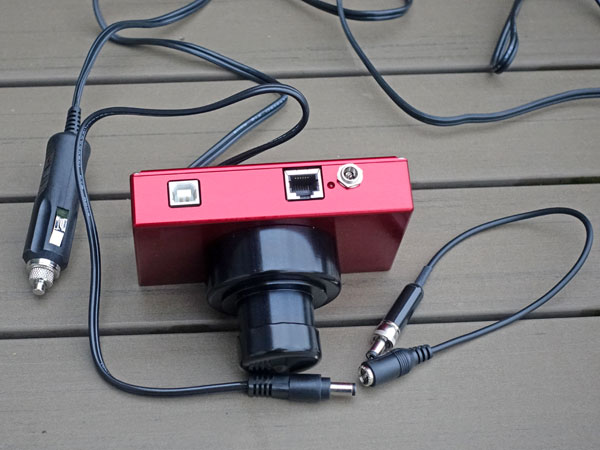 |
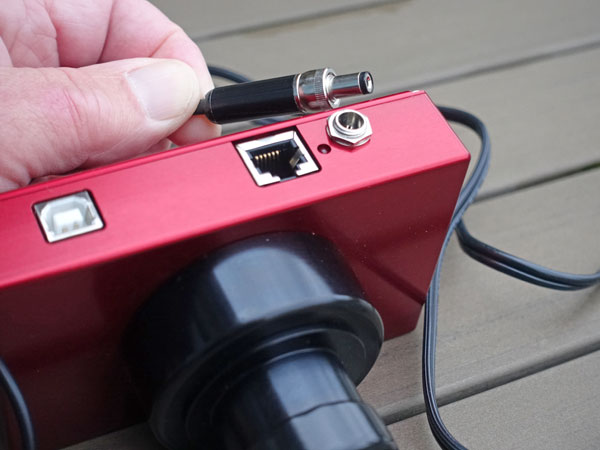 |
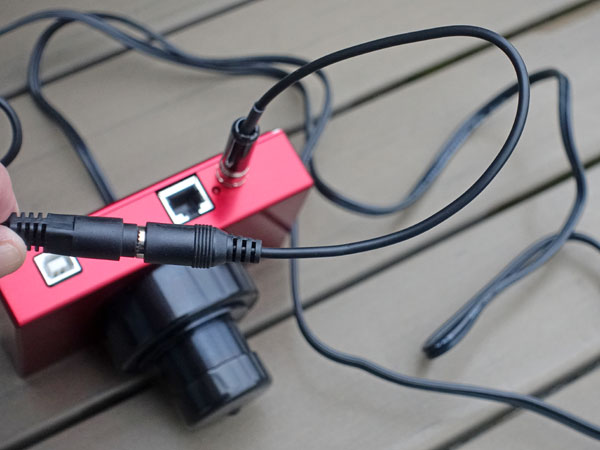 |
Teleskop-Leasing added the adapter cable to the package to fight one often stated criticism, namely that the power cable gets loose when the camera is moved by the mount and thus, the recording is interrupted. I do not understand why Atik cannot deliver the camera with a "screw in" power cable. That's probably a matter of pennies...
Because of the length of the plug of the power supply cable, the plug sits firmly in the mating connector of the adapter cable. Here you do not have to worry that the connection gets loose easily. According to my first experiences, the adapter effectively prevent interruptions of the power supply.
The Things You Need...
The easiest and quickest approach to observing sky objects is still to place a small table Dobsonian telescope on the terrace table. A Newton tube like the Explorer 150PDS needs a mount, which in the case of astrophotography, has to be be a GoTo mount and accordingly requires a power supply (12 V).
For doing astrophotography, you also need a camera, an additional power port (12 V) for the camera, and a computer with the appropriate camera software. In the case of the Atik Infinity, this is a software tailored to this camera (meanwhile, other Atik cameras use this software as well), which only runs on Windows. Thus, on my Apple Macintosh I also need a Windows emulator to be able to run the software at all.
Depending on the used tube, I may also need additional focal length extenders or reducers.
In the following, I present two "example configurations": (1) for the Newtonian Explorer 150PDS tube, which I do not own anymore, (2) for the Schmidt-Cassegrain C8 tube, which I bought at the end of 2019:.
| Explorer 150PDS (f5, 150/750) | C8 with Visual Back and Reducer/Corrector (f/6,3, 203/1280) | C8 with 1.25" Visual Back (f/10, 203/2032) | ||
|
|
|
Below you can see some example configurations with various telescopes:
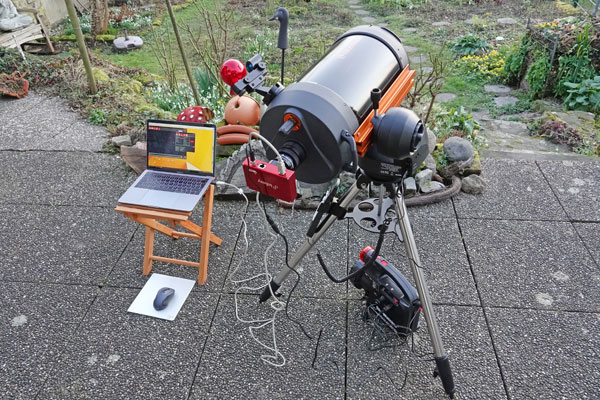 |
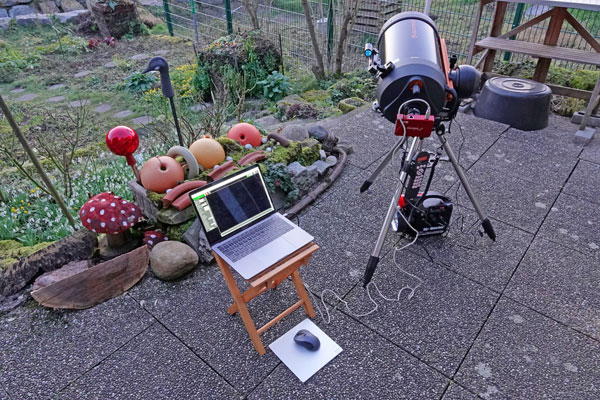 |
 |
And afterwards you also need time and patience to edit the many photos and publish them if necessary. This is much less effort than with "real" astrophotography, but it does take time!
Atik Infinity at Different Telescope Tubes
Somewhere I read that the Atik Infinity camera works best with focal lengths of 400/500 to 1000 mm; unfortunately, I cannot find the source for this statement anymore... However, I can confirm that this statement applies to the tubes that I owned at the time when I bought the camera. I found all this out with some effort over time, and it is described in more detail on page Atik Infinity Colour Camera - First Observation Sessions. Therefore I will here provide only a summary of my experiences with the tubes that I used the camera on!
Telescope Tubes until End of 2019
Heritage 100P (100/400 mm)
Update: I no longer own the Heritage 100P
The Atik Infinity camera can, technically speaking, be used at the Heritage 100P. But I cannot get into focus with the camera alone, it delivers only blurred photos.
As I found out on the Internet, the focus point can be moved in the desired direction, i.e. outwards, using a Barlow lens or a focal length extender. According to the magnification factor (1.5 x, 2 x or 3 x), the focal length is extended, which might be an advantage. However, the aperture ratio also decreases accordingly, requiring longer exposure times. My results achieved with the Heritage 100P with focal length extension were rather "poor", though. I therefore did not use the camera on this tube after my first tests.
Photos: Atik Infinity at the Heritage 100P
| View of the complete equipment including the power pack (for the mount and the camera) and a laptop computer (for running the Atik Infinity software) | ||
Explorer 150PDS (150/750 mm)
Update: I no longer own the Explorer 150PDS.
With the Explorer 150 PSD telescope tube, the camera comes into focus without any problems (i.e. without Barlow lens or focal extender). By the way, "PDS" means "designed for photography" (Photo) and "focuser with 10:1 fine adjustment" (Dual Speed 10:1 focuser).
I had the best results with this tube at the beginning; the results are much better than with the Heritage 100P. With appropriate post-processing, they do not seem to be far from what can be achieved with my equipment (then...). They are comparable to the results of the eVscope, if not even better.
Photos: Atik Infinity at the Explorer 150 PDS
Top left and center view of
the complete equipment including the power pack (for the mount and
the camera) and a laptop computer (for
running the Atik Infinity software) |
||
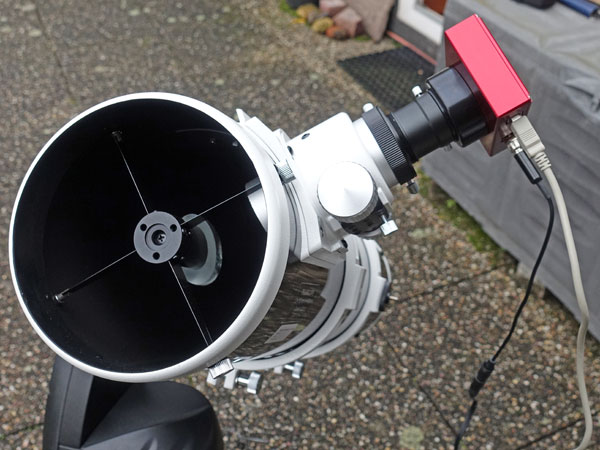 |
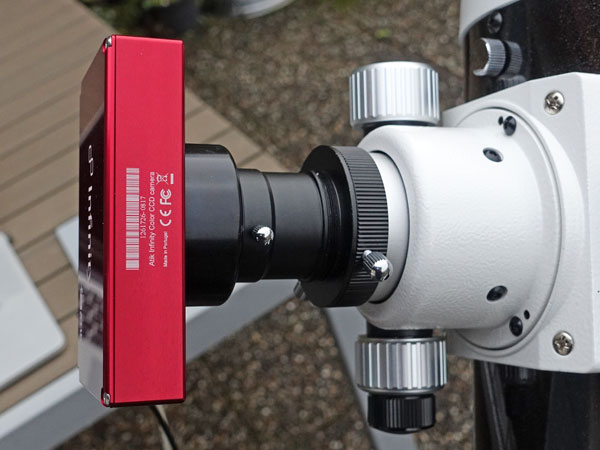 |
|
Skymax-102 (102/1300 mm), Skymax-127 (127/1500 mm)
Update: I no longer own the Skymax-102.
For my two Maksutov tubes (at that time, I still owned two such tubes...), I got a simple 2 x focal length reducer from TS, which can also be converted into a 3x reducer with an extension sleeve; in fact, however, I only get a factor of 2.31 on the Skymax-127.
At the Skymax-127, I briefly tested the camera with the focal length reducer plus extension sleeve, and the results looked satisfactory. I did not use the Atik Infinity camera at the Skymax-102, but the same should apply to both tubes. Later, I tested it also without reducer in a dry run, and this seemed to work as well.
Photos: Atik Infinity at Skymax-127
| View of the complete equipment including the power pack (for the mount and the camera) and a laptop computer (for running the Atik Infinity software) | ||
Newer Telescope Tubes (from the End of 2019)
I present my experiences with tese tubes on page Atik Infinity Colour Camera - Further Experiences.
My Pain Points...
As you can read on page Atik Infinity Colour Camera - First Observation Sessions , the weather is a perennial problem. Clouds come in quickly and I you have set everything up, the sky is already overcast. But I also have some other problems when using the Atik Infinity camera, some of which I would like to introduce.
GoTo Control
My Star Discovery GoTo mount is not the most accurate GoTo control you could wish for, but it is certainly also due to my sloppy alignment when targets are not approached correctly. Even with the Celestron StarSense module I had problems with accessing objects and only found out afterwards what I had actually photographed. If you have a good working GoTo control, you do not have this problem!
Focusing
I always had problems to focus the camera exactly. A Bahtinov or other focusing mask can help. I had bought these for the Explorer 150PDS, but I had not used the camera in the meantime. And meanwhile, I sold the Explorer together with the focus masks and bought a Celestron C8, for which I need to buy new focus masks...
Software
The Atik Infinity software is basically easy to use, but it took me some time to get used to it. Furthermore, some things are not implemented correctly and are misleading. After a first reaction, Atik punished my respective hints with disregard... More about this on page Atik Infinity Colour Camera - Software.
Preliminary Conclusions
Focus or not?
As a "first information," I can already pass on that I cannot use the Atik Infinity camera on the Heritage 100P as such, because the camera does not come into focus, that is, delivers only blurry images. The use of Barlow lenses or focal length extenders (focal length extenders) has helped, but has produced unsatisfactory results. Therefore I did not use the Atik Infinity on this telescope anymore.
I also found out that I come into focus with my Explorer 150PDS without the need of a Barlow lens or focal extender. This is not surprising since the Explorer 150PDS is an adapted version of the Explorer 150 that is suited to astrophotography. And this tube also delivered the best results of all of my tubes together with the Atik Infinity. Maybe, my new telescopes, the C8 and the TLAPO1027, will be on par...
Finally, I was able to use the Atik Infinity at the Skymax-127 Maksutov-Cassegrain tube with a focal length reducer. I expect similar results at the Skymax-102, but did not test this (and am no longer able to do so...).
Pain Points, Outlook...
My pain points, but also other reasons, have led to the fact that I did not use the camera since April 2018 (up to March 2020), which is of course a great pity. I hoped to use it again with the C8 and my two refractors (which I did between 2020 and 2022), but I had to wait and see how the eVscope and the camera would get along. Conclusion: The Atik Infinity delivered the better photos, whereas with the eVscope I could start observing and photographing fast. And the latter has always won with me...
Note: Over Christmas 2022, I sold my Atik Infinity camera (transferred on January 5, 2023). I therefore cannot report any further experiences with it here. |
Links
- Atik company Website, UK: www.atik-cameras.com
- Product page: www.atik-cameras.com/product/atik-infinity/
- Pages from German distributors for the Atik Infinity camera:
- Teleskop-Leasing (bought the camera here): www.teleskop-leasing.de/produkte/kameras/atik-infinity-farb-ccd-kamera- (in German)
- Teleskop-Spezialisten: www.teleskop-spezialisten.de/shop/Astrofotografie/Atik-Infinity-FARB-CCD-Kamera-11mm-Sensor-automatische-Aufnahmen::2166.html (in German) - www.teleskop-spezialisten.de/shop/Astrophotography/::2166.html (in English)
- Teleskop-Service/Express: www.teleskop-express.de/shop/product_info.php/info/p8213_Atik-Infinity-FARB-CCD-Kamera---Sensor-D-11-mm--vollautomatisch.html (in German) - www.teleskop-express.de/shop/product_info.php/info/p8212_Atik-Infinity-B-W-CCD-Camera---Sensor-D-11-mm--fully-automatic.html (in English)
- Astroshop: www.astroshop.de/kameras/atik-kamera-infinity-color/p,4831 (in German) - www.astroshop.eu/cameras/atik-camera-infinity-color/p,48316 (in English)
- Testing the 16 bit Atik Infinity camera with small telescopes (x-bit-astro-imaging, S.J. Wainwright): x-bit-astro-imaging.blogspot.de/2016/02/testing-16-bit-atik-infinity-camera.html
- ICX825 Based Astro-Video Camera Comparison (Jim Thompson): http://karmalimbo.com/aro/reports/Test%20Report%20-%20825%20Sensor%20Camera%20Comparison_07Oct2016.pdf
- Bis zur Unendlichkeit…. (Peter Oden, Peters Astroblog): videoastronomie.net/bis-zur-unendlichkeit
- Peter Oden: Videoastronomie: Der Himmel live und in Farbe. Sterne und Weltraum, Juni 2017. (in German)
- Electronically Assisted Astronomy with Atik Infinity (Fallenangel/Franz Müller): fallenangels2ndlife.dyndns.org/2017/03/01/electronically-assisted-astronomy-wit-atik-infinity/
- Einfach und schnell fotografieren mit der Atik Infinity (Sample photos, Peter Weigel, Teleskope Weigel): www.zudensternen.de/Atik_Infinity.html
- Review of the Atik Infinity Color Video Astronomy Camera (astrojedi, Live Astronomy blog): videoastronomy.blogspot.de/2016/02/review-of-atik-infinity-color-video.html
- Sky-Watcher Heritage 100P Information (4" Dobson)
- Sky-Watcher Explorer 150PDS Information (6" Newton)
- Sky-Watcher Skymax-127 OTA Information (5" Maksutov-Cassegrain)
- Sky-Watcher Star Discovery AZ GoTo Mount Information
- Ronald Stoyan (2014). Deep Sky Reiseführer, Oculum Verlag: www.oculum-verlag.de/detailview?no=2015 (in German)
- See also my page offering Astronomy Links.
| 27.03.2023 |

